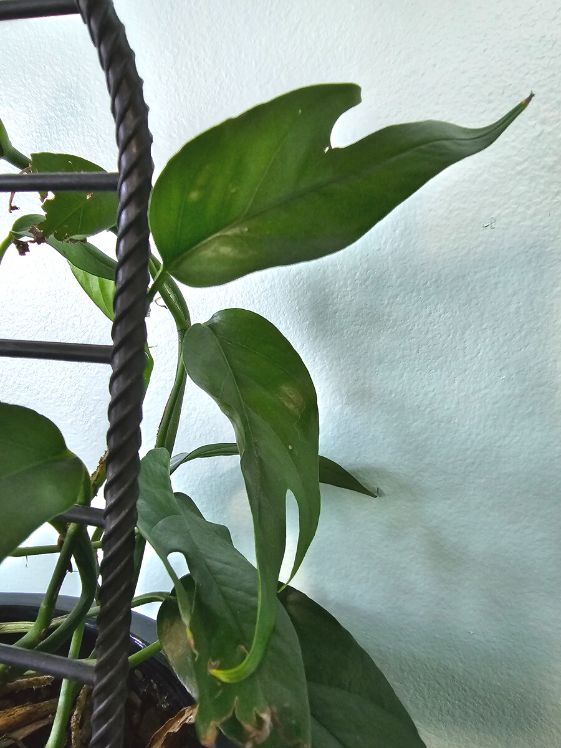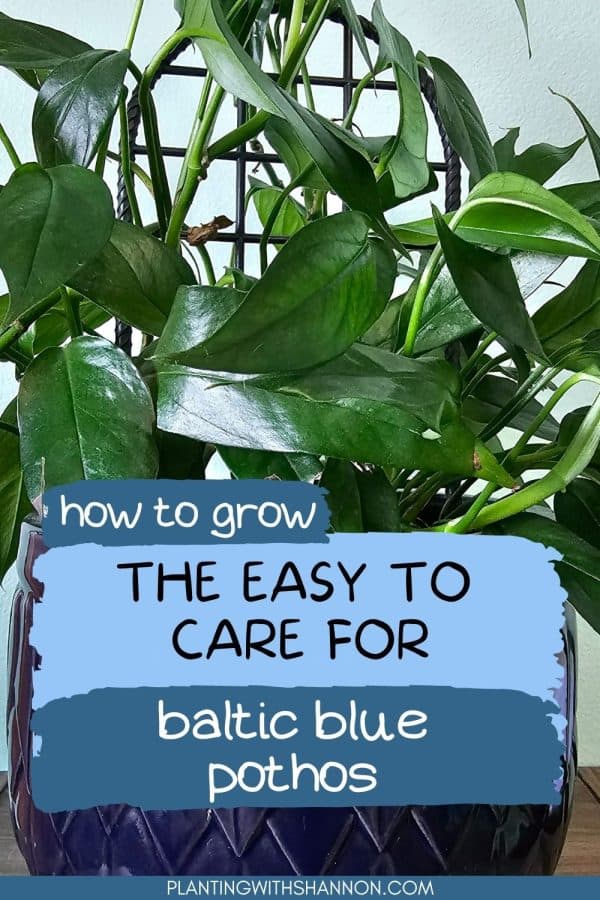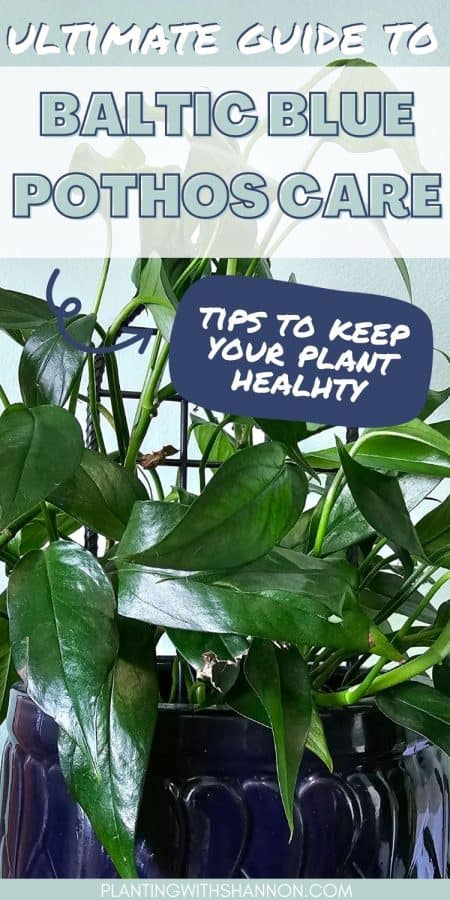The beautiful baltic blue pothos is an easy-to-care-for beginner-friendly plant.
It brings life and vibrancy to any space with its beautiful blue-green leaves and trailing stems.
To keep your baltic blue pothos healthy and growing strong, it’s important to know how to care for it properly. Let’s take a look at some tips for keeping your plant in top condition.
This post may contain affiliate links. That means if you click on them and buy something, I may receive a small commission. Read my Disclaimer Policy to learn more. As an Amazon Associate, I earn from qualifying purchases.

What is a baltic blue pothos?
Baltic blue pothos houseplants are tropical plants that are a cultivar of the Epipremnum pinnatum plant. This species is native to tropical regions such as Southeast Asia and the Pacific Islands.
It’s an incredibly popular houseplant due to its low-maintenance care and its beautiful dark green leaves with a bluish cast to them.
The leaves of this plant are longer and narrower than the Epipremnum aureum, the most common of which is the golden pothos, and develop fenestrations as the plant gets larger.
The trailing stems can reach 12 feet or more in length, making this plant ideal for hanging planters or other vertical planters.
Are baltic blue pothos plants poisonous/toxic?
Like all pothos varieties, all parts of the baltic blue pothos are poisonous to humans, cats, and dogs.
While it is unlikely to cause death, it can still cause discomfort and harm to you or your pets if any part is consumed.
Baltic blue pothos contains a substance called calcium oxalate. This substance is sharp like broken glass and can shred the skin and digestive tract.
It should be kept away from small children and pets that may be tempted to eat it.
How to care for baltic blue pothos

Now that you know what a Baltic Blue Pothos is and why it’s important to keep it away from children and pets, let’s take a look at how to care for this low maintenance plant.
Lighting
Baltic Blue Pothos is an easy-to-care-for houseplant that can thrive in a variety of lighting conditions. However, providing the right amount of light is crucial for the plant’s growth and overall health.
As a rule of thumb, Baltic Blue Pothos prefers bright indirect light. Direct sunlight can scorch the leaves and cause them to lose their unique coloring. On the other hand, low light conditions can cause the plant to grow slowly and become leggy.
The best light for this plant is an east-facing window. A south-facing window has too much direct sunlight, but can work if you put the plant off to the side of the window instead of directly in front of it.
Artificial light, such as fluorescent or LED lights, can be used for additional light if you don’t have a location that has bright, indirect light for your baltic blue pothos.
Keep in mind that the plant’s additional lighting requirements may vary depending on the time of year and the location of your home.
During the winter months, when there is less indirect sunlight due to the shorter days, you may need to provide your baltic blue plants with additional light to ensure their growth and health.
Watering
Baltic Blue Pothos are relatively easy to care for, but one of the most important aspects is getting their watering needs right. These plants are native to tropical forests, so they prefer consistently moist soil.
It’s important not to let the soil dry out completely, but at the same time, too much water can lead to root rot. A good rule of thumb is to water when the top inch of soil feels dry to the touch.
One way to reduce the chance of too wet of soil is to have a pot with drainage holes. This allows the excess water to run out of the pot.
Humidity
Baltic Blue Pothos is native to tropical regions, which means it prefers higher humidity levels. But it can tolerate lower levels of humidity if it is getting enough water.
If your house has low humidity, you can increase the moisture levels around your plant by grouping other plants near it.
Another option is to use a humidifier to increase the humidity in your home.
I personally don’t use a humidifier for any of my pothos, mainly because I live where it can get to -20 degrees Fahrenheit (or colder) in the winter. When it’s that cold out too much moisture in my house leads to moisture on my windows and potential mold growth.
If you choose to go the humidifier route, just make sure to check your windows and walls for moisture and mold.
Temperature
Baltic Blue Pothos prefers warm temperatures between 65 and 85 degrees Fahrenheit.
If the temperature drops below 50 degrees, the plant may experience shock or damage to its leaves.
But, while it can’t go below 50 degrees, it can tolerate low 60s at night. At least mine can. The room its in typically gets down to between 62 and 64 nightly in the winter and my baltic blue is doing well. The day usually sits between 66 and 70.
Soil
Baltic Blue Pothos is a low-maintenance plant that can thrive in a variety of soil types. However, it prefers well-draining soil that is rich in organic matter.
Most commercially sold potting mixes will work for the baltic blue pothos. I prefer Miracle Grow potting soil, the regular potting mix not the moisture control mix. I use it straight out of the bag or sometimes I add orchid bark to make the mix a little chunkier.
Fertilizing
When it comes to fertilizer, Baltic Blue Pothos is not a heavy feeder. A balanced, water-soluble fertilizer is sufficient. It is recommended to fertilize the plant once a month during the growing season, which is from spring to fall. During the winter months, reduce the frequency of fertilization to once every two to three months.
It is important to avoid over-fertilizing the plant as it can lead to salt buildup in the soil, which can damage the roots. Signs of over-fertilization include yellowing leaves, stunted growth, and wilting. If you notice any of these signs, stop fertilizing the plant and flush the soil with water to remove excess salts.
Pruning Your Plant
Pruning is an important part of Baltic Blue Pothos care. It helps to keep the plant the size you want and encourages new, bushy growth.
When pruning, make sure to cut just above a leaf node, as this will encourage new growth from that point.
Regular pruning will help to keep your Baltic Blue Pothos looking healthy and vibrant, and will also help to prevent it from becoming too large and unwieldy.
Repotting Frequency
Baltic Blue Pothos will benefit from repotting every two to three years or as it outgrows its current pot.
When repotting, make sure to use a pot with drainage holes and use soil that is well draining and rich in organic matter.
If the plant is rootbound you should go up one pot size. Otherwise, you can just shake off as much of the old soil as possible without damaging the roots and repot it into the same pot with fresh potting soil.
Propagating baltic blue pothos
Baltic Blue Pothos is an easy plant to propagate and I prefer to use the water propagation method with it.
To propagate the Baltic Blue Pothos by stem cuttings, follow these simple steps:
- Choose a healthy stem with at least two leaves
- Cut the stem just below a node (where the leaf meets the stem)
- Remove the lower leaves from the stem
- Place the stem cutting in a jar of water or a pot filled with soil
- Keep the cutting in a bright, indirect light and change the water as needed
- After a few weeks, roots will start to grow from the stem cutting
Once the roots are at least an inch long, you can transplant the cutting into a new pot.
Propagation is a great way to expand your collection of Baltic Blue Pothos or to share this beautiful plant with friends and family.
How Big Does a Baltic Blue Plant Get?
The size of the Baltic Blue Pothos depends on how it is cared for. Generally, it can grow anywhere 12 feet long or more if given proper care.
If you are looking to keep your plant smaller, regular pruning is necessary as the plant can become quite large and unwieldy with age.
Common problems with baltic blue pothos
Even though the baltic blue pothos is easy to care for, there are still a few common problems you may come across while caring for this beautiful plant.
Leggy growth
Leggy growth is common when the plant isn’t receiving enough light. Move it to a brighter spot and prune the leggy stems back to encourage new growth.
Yellow leaves
Yellow leaves are typically caused by a watering issue, either over or underwatering.
To fix this issue, start checking the soil before you water. If it is very dry, water and then check the soil a few days sooner than you just did.
If the soil is still wet, wait a few more days and check again.
The yellow leaves can be pruned off the plant as they will never green up and will eventually die.
Leaves Aren’t Fenestrating

Baltic blue leaves will develop fenestrations when the plant is happy and is producing larger leaves. Young plants and plants that are only putting out small leaves will not produce fenestrations.
Giving your plant enough light and water, along with just allowing it to age, will help to encourage larger leaves.
Fertilizing every month or two during the growing season can also help to promote new, healthy growth.
Common pests
Mealybugs, spider mites, and fungus gnats are the most common pests that affect Baltic Blue Pothos. These pests can cause leaves to yellow, wilt, and fall off.
To prevent an infestation, regularly inspect the plant and keep it clean of debris. If you do notice an infestation, you need to treat for the specific pest you have.
Mealybugs will respond best to early treatment of spot treating with a cotton swab and rubbing alcohol.
Spider mites can be difficult to get rid of but I have had success with weekly showers and applications of neem oil.
Fungus gnats are the least likely to cause damage to your plant and can be gotten rid of by using yellow sticky traps.
FAQ
Can I keep baltic blue pothos outdoors?
Baltic blue pothos will grow outside in the right conditions. In colder climate areas it will grow as an annual as it will die when the weather turns cold.
In warmer climate areas it will grow year round but it’s best to check your local laws. Some areas consider all pothos an invasive species and you should make sure it’s okay to grow it where you live.
Does baltic blue pothos need a moss pole?
No, it doesn’t need a moss pole. Baltic blue pothos can be grown in a hanging basket or as a trailing plant. Or you can give it a moss pole or trellis to get it to grow upwards instead of trailing.
How do you make baltic blue pothos bushier?
Baltic blue pothos is a vine and is naturally not bushy. To get it bushier you can prune it back and it will put out new, bushier growth where you pruned it.
But the best way to get a busy baltic blue pothos is to propagate it and then put the new plants into the same pot with the original plant. This will make it look bushier.
Related posts
27 Types of Pothos to Grow in Your Home
How To Care For A Marble Queen Pothos
The Ultimate Guide To Caring For A Neon Pothos Plant





